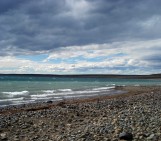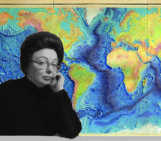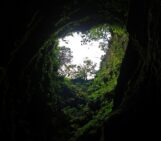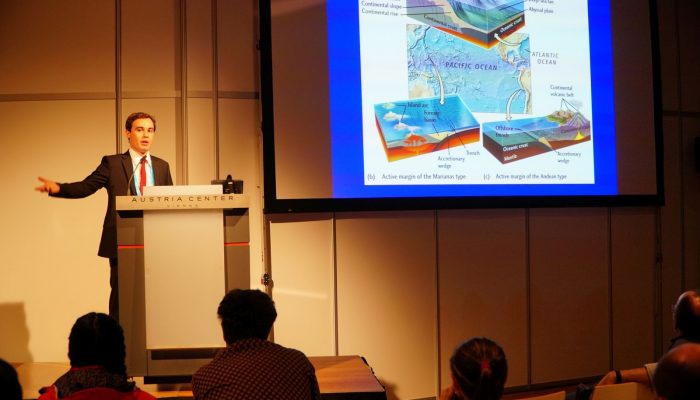
Geotalk is a regular feature highlighting early career researchers and their work. Following the EGU General Assembly, we spoke to João Duarte, the winner of a 2017 Arne Richter Award for Outstanding Early Career Scientists. João is a pioneer in his field. He has innovatively combined tectonic, marine geology and analogue modelling techniques to further our understanding of subduction initiation and wrench tectonics. Not only that, he is a keen science communicator who believes in fostering the next generation of Earth scientists.
Thank you for talking to us today! Could you introduce yourself and tell us a little more about your career path so far?
I am a geologist by training. I gained my undergraduate degree from the University of Lisbon and I stayed there to research geodynamics as part of my PhD which I finished in 2012. As I was coming to the end of writing up my thesis I moved to Monash University, in 2011, to start a postdoc.
Yes! I worked on my PhD and a postdoc at the same time, but I was only really finishing up. My thesis was almost ready. When I moved to Australia the defence was outstanding, but otherwise I was almost done.
My PhD thesis focused on the reactivation of the SW Iberian margin. It was the very first time I came across the problem of subduction initiation and that has become a big focus of my career to date.
My postdoc came to an end in 2015 and I moved back to Portugal and took up a position at the Faculty of Sciences of the University of Lisbon where I’ve started building my own research group [more on that later on in the interview].
I’ve always been passionate about science. It started when I was a kid, I’ve always been interested in popular science. My favourite writers are Isaac Asimov and Carl Sagan.
During EGU 2017, you received an Arne Richter Award for Outstanding Young Scientists for your work on subduction initiation and wrench tectonics. What brought you to study this particular field?
On the morning of the 1st of November 1755, All Saints Day, when many Portuguese citizens found themselves at church attending mass, one of the most powerful earthquakes ever document struck off the coast of Portugal, close to Lisbon.
It was gigantic, with an estimated magnitude (Mw) 8.5 or 9. It triggered three tsunami waves which travelled up the Tagus River, flooding Lisbon harbour and the downtown area. The waves reached the United Kingdom and spread across the Atlantic towards North America too.
The combined death toll as a result of the ground shaking, tsunamis and associated fires may have exceeded 100,000 people.
The event happened during the Enlightenment period, so many philosophers and visionaries rushed to try and understand the earthquake. Their information gathering efforts are really the beginning of modern seismology.
But the 1755 event wasn’t an isolated one. There was another powerful earthquake off the coast of Portugal 200 years later, in 1969. It registered a magnitude (Mw) of 7.8.
This earthquake coincided with the development of the theory of plate tectonics. While Wegener proposed the idea of continental drift in 1912, it wasn’t until the mid-1960s that the theory really took hold.
People knew by then that the margins of the plates along the Pacific were active – the area is famous for its powerful earthquakes, explosive volcanoes and high mountain ranges. Both the 2004 Indian Ocean and 2011 Thoku (Japan) earthquakes and tsunamis were triggered at active margins.
But the margins of the Atlantic are passive [where the plates are not actively colliding with or sinking below one another, so tectonic activity – such as earthquakes and volcanoes – is minimal]. So, it was really strange that we could have such high magnitude quakes around Portugal.
A large European project was put together to produce a map of the SW Iberian margin and the Holy Grail would be to locate the source of the 1755 quake. The core of my PhD was to compile all the ocean floor and sub-seafloor data and produce a new map of the main tectonic structures of the margin.
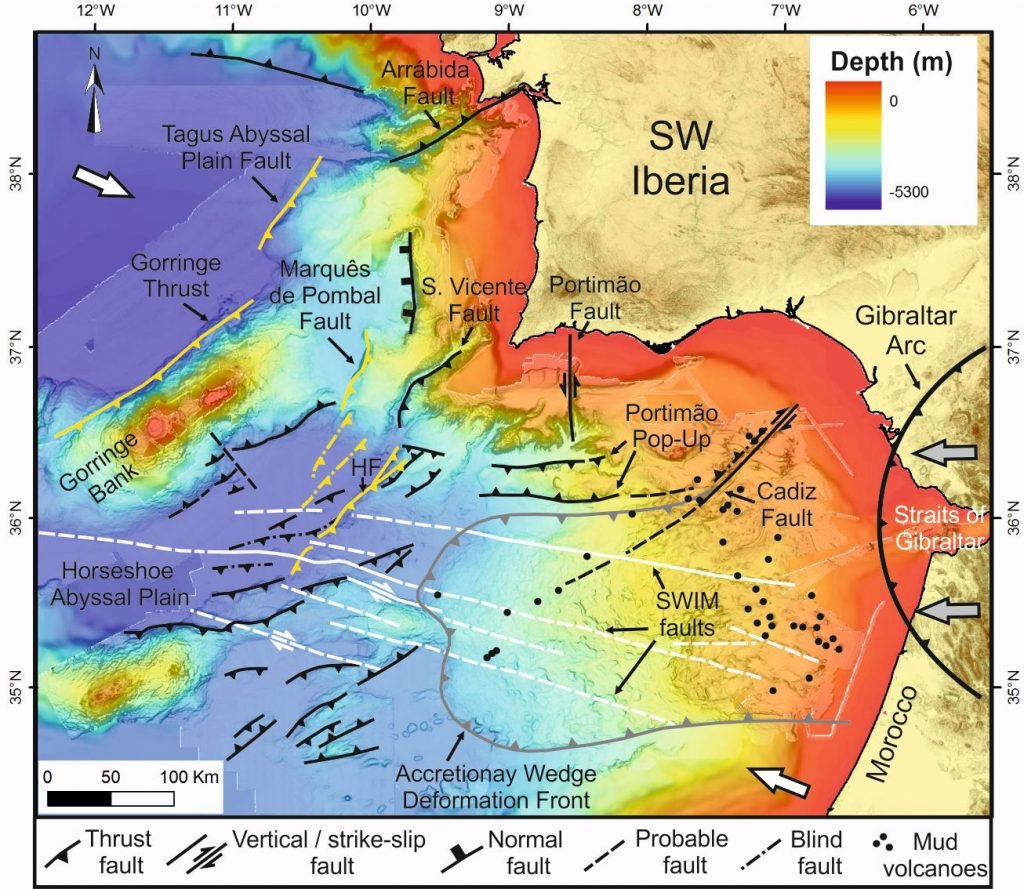
Tectonic map of the SW Iberia margin. In grey the deformation front of the GibraltarArc, in white the strike-slip fault associated with the Azores-Gibraltar fracture zone, and in yellow the new set of thrust faults that mark the reactivation of the margin (Duarte et al., 2013, Geology)
What did the new map reveal?
Already in the 70s and later in the late 90s, researchers started to wonder if this margin could be in a transition between passive to active: could an old passive margin be reactivated? If so, could this mean a new subduction zone is starting somewhere offshore Portugal?
The processes which lead a passive margin to become active were unclear and controversial. All the places where subduction is starting are linked to locations where plates are known to be converging already.
The occurrence of the high magnitude earthquakes, along with the fact that there is structural evidence (folding, faulting and independent tectonic blocks) of a subduction zone in the western Mediterranean (the Gibraltar Arc) suggested that it was possible that a new subduction system was forming in the SW Iberian margin.
The new ocean floor and seismic data revealed three active tectonic systems, which were included in the map. The map shows the margin is being reactivated and allowed identifying the mechanism by which it could happen: ‘Subduction invasion’ or ‘subduction infection’ (a term first introduced by Mueller and Phillips, 1991).
I’d like to stress though, that the map and its findings are the culmination of many years of work and ideas, by many people. My work simply connected all the dots to try to build a bigger picture.
So, what does ‘subduction infection and invasion’ involve?
Subduction zones, probably, don’t start spontaneously, but rather they are induced from locations where another subduction system (or an external force, such as a collisional belt) already exists.
For example, if a narrow bridge of land connects an ocean (as is often the case) where subduction is active to one where the margins are passive. The active subduction zones from one can invade the passive margins and activate them. You see this in the other side of the Atlantic (where subduction zones have migrated from the Pacific), in the Scotia and the Lesser Antilles arcs.
We also know this has happened in past. But Iberia might be the only place where it is happening currently. And that is fascinating!
Earlier on you said that the ‘Holy Grail’ moment of the map would be if you could find the source of the 1755 earthquake. Did you?
No. Not entirely. The source of the earthquake is probably a complex fault, where multiple faults ruptured to generate the quake, not just one (as is commonly thought).
In your medal lecture at the General Assembly in 2017 (and in your papers) you allude to the fact that the reactivation of the SW Iberian margin has even bigger implications. You suggest that staring of subduction process in the arcs of the Atlantic could ultimately lead to the ocean closing altogether?
The Wilson cycle defines the lifecycle of an ocean: first it opens and spreads, then its passive margins founder and new subduction zones develop; finally, it consumes itself and closes.
So, the question is: if subduction zones are starting in the Atlantic will it eventually close?
There are a few things to consider:
The ocean floor age is limited. It seems that it has to start to disappear after about ~ 200 million years (the oldest oceanic lithosphere is ~ 270 million years old). Passive margins in the Earth history also had life spans of the order of ~ 200 Ma, suggesting that this may not be a coincidence. I suspect that there is a dynamic reason for this…
Most researchers agree that the next major oceanic basin which is set to close is the Pacific. The Americas (to the east) are moving towards East Asia and Australia at a rate of 3-4 cm yr-1, so it should close in roughly 300 million years.
We also know that the Atlantic has been opening for 200 million years already. If you believe that the closing of the Pacific indicates that continental masses have been slowly gliding towards each other to form the next supercontinent (a theory know as extroversion); then the Atlantic has to continue to open until the Pacific closes. This would mean that ocean floor rocks in the Atlantic would be very old (up to 500 million years old!) – highly unlikely given the oldest existing oceanic rocks are 270 million years old.
The map I made during my PhD showed that the Atlantic oceanic lithosphere is already starting to break-up and is weakened.
All the pieces combined, I think the most likely outcome is that the Pacific and the Atlantic will close at the same time. This scenario would require other oceanic basins to form, and that’s possible in the existing Indian Ocean and/or the Southern Ocean. Present-day continents would be brought together to form a new supercontinent, which we called Aurica.
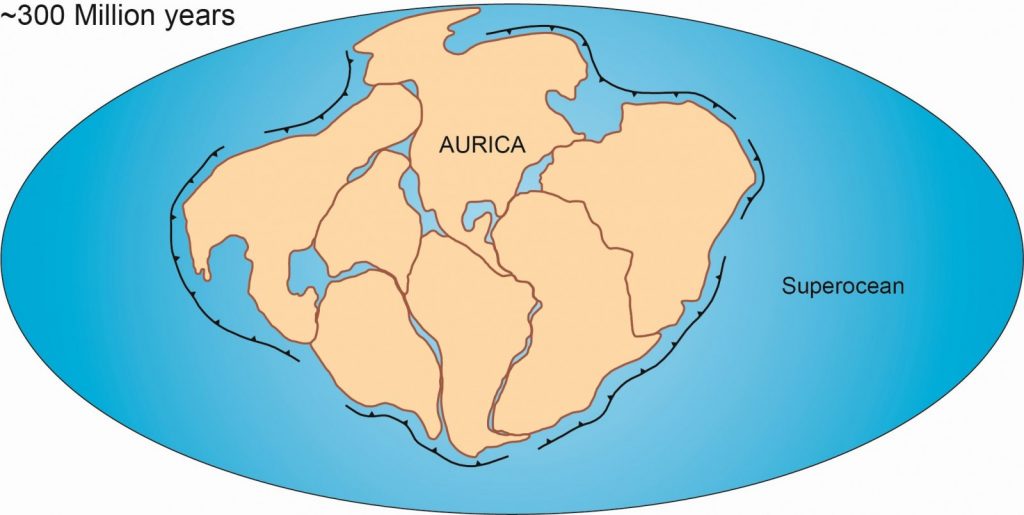
Aurica – the hypothetical future supercontinent formed as the result of the simultaneous closure of the Atlantic and the Pacific oceans (Duarte et al., 2016, Geological Magazine).
If you take into consideration present-day plate velocities the supercontinent could be fully formed in approximately 300 million years’ time. We expect Aurica to be centred slightly north of the equator, with Australia and the Americas forming the core of the landmass.
With those findings, it is obvious why subduction has been a recurring theme in your career as a researcher. But what sparked your initial interest in geology and then tectonics in general?
I spent a lot of time outdoors as a kid. I was always curious and fascinated by the outdoor world. I joined the scouts when I was eight. We used to camp and explore caves by candle-light!
When I was 14 I took up speleology; there are lots of caves in the region I grew up in, in Portugal. As amateurs, my speleology group participated in archaeological and palaeontological work. The rocks in the region are mainly of Jurassic age and contain lots of fossils (including some really nice dinosaurs).
The outdoors became part of me.
I knew early on that I didn’t want a boaring job with lots of routine. I wanted a career that would allow me to discover new things.
Geology was the most obvious choice when picking a degree. I felt it offered me a great way to stay in touch with the other sciences too – physics via geophysics and biology through palaeontology.
In my 2nd year at university, I was invited to help in an analogue lab looking at problems in structural geology and geodynamics.
I was always attracted to the bigger picture. Plate tectonics unifies everything. I like how by studying tectonics you can link a lot of little things and then bring them together to look at the bigger picture.
What advice do you have for early career scientists?
When I found out about the award I was shocked because I wasn’t expecting it at all.
I always felt I wasn’t doing enough [in terms of research output]. I think that early career scientists are being pushed to limits that are unreasonable; the competition is intense. It’s not always obvious, but there is a lot of pressure to publish. But there are also a lot of very good people whose publication record doesn’t necessarily reflect their skill as a scientist.
The award made me realise I was probably doing enough!
Moving to Australia was KEY. Moving and creating collaborations with different people will make you unique. You don’t want to stay in the same institution. [By doing so] you become very linear. There are a number of schemes available (like Marie Curie and Erasmus) which allow you to move. Use these to the fullest. Moving allows you to see problems from different perspectives. And you will become more unique as a scientist.
There a lot of bright young scientist – never have we had so many – we are all unique, but you have to find the uniqueness in yourself. Most of all have fun. Do science for the right reasons and remember that people still recognise honest hard work (the award showed me that).
Interview by Laura Roberts, EGU Communications Officer.
References
Duarte, J. C., Rosas, F, M., Terrinha, P., Schellart W, P., Boutelier, D., Gutscher, M-A., and Ribeiro, A.,: Are subduction zones invading the Atlantic? Evidence from the southwest Iberia margin, GEOLOGY, 41, 8, 839–842, https://
Duarte, J. C., and Schellart W, P.,: Plate Boundaries and Natural Hazards, Geophysical Monograph, 219 (First Edition), ISBN: 978-1-119-05397–2, 2016
Duarte, J., Schellart, W., & Rosas, F.,: The future of Earth’s oceans: Consequences of subduction initiation in the Atlantic and implications for supercontinent formation, Geological Magazine, 1–14, https://doi.org/10.1017/S0016756816000716, 2016.
Purdy, G.M.,: The Eastern End of the Azores-Gibraltar Plate Boundary, GJI, 43, 3, 973–1000, https://doi.org/, 1975
Mueller, S., Phillips, R, J.,: On The initiation of subduction, JGR, 96, B1, 651-665, https://doi.org/
Ribeiro, A., Cabral, J., Baptista, R., and Matias, L.,: Stress pattern in Portugal mainland and the adjacent Atlantic region, West Iberia, Tectonics, 15, 3, 641–659, https://doi.org/

